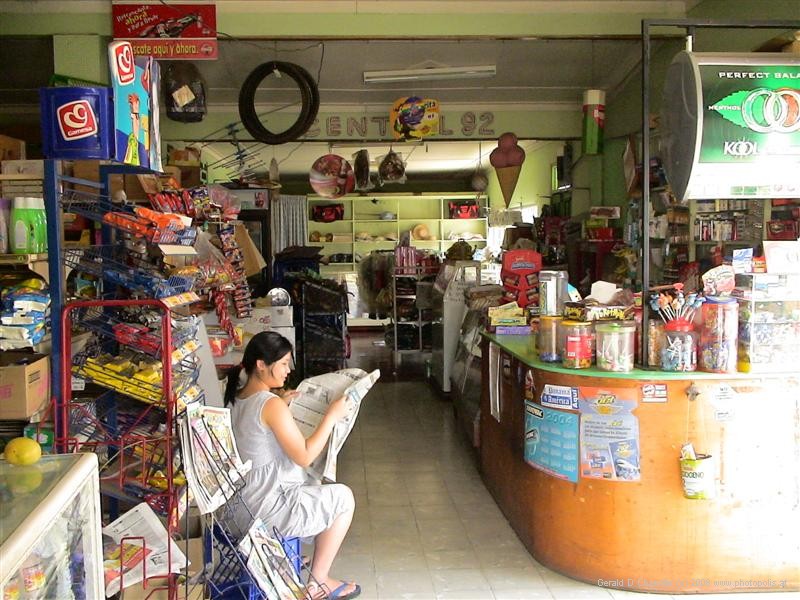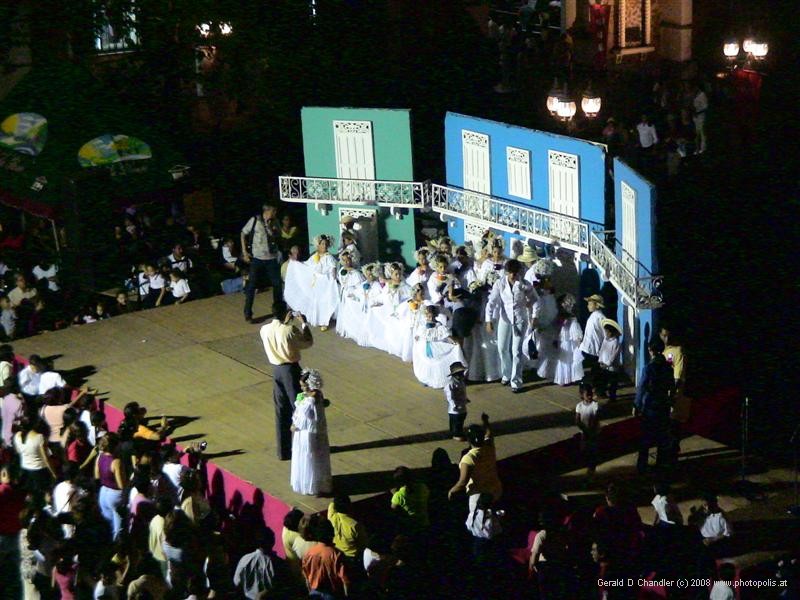Home | Front Page | Index | Blog | New | Contact | Site Map
David
Boquette
Las Lajas
Santiago
Santa Fe
Azuero-Chitre
El Valle
Panama City
Panama Canal
STRI
Porto Belo
San Lorenzo
Colon
Isla Grande
Lady Kis
Foto Show

Route Maps
Belize
Guatemala
Honduras
Nicaragua
Costa Rica
Mexico 2003-04:
2003-04
The Azuero penisula sticks down on the map of Panama as the west side of the Gulf of Panama. It is not quite a square, being about 90 km north-south and 75 east-west. Most of the peninsula is relatively low, varying from sea level to a few hundred meters higher, but in the southwest there are some hills that reach above 500 M. All of the Panamanian provinces of Herrera and Los Santos are contained in the peninsula as well as the south west sliver of Veraguas.

School named for the leading "Independista", Tomas Herrera |
Chitre is the main town of the Azuero pennisula and the main town of Herrera. Not large by world standards, it is big enough to have several blocks of commercial districts. The center is a nice square, with the church on the east side. The drive from the east-west Interamerican highway south to Chitre is through very pleasant, sometime gorgeous rolling green land as is the drive further south to Pedasi, on the end of the peninsula.

Shop in Los Santos |
Just four kilometers away is the much smaller village of Los Santos. It is not the main town of Los Santos province; that honor goes to more centrall located Los Tablas. One of La Villa de Los Santos claims to fame is that the conspirators who lauched the independence of Panama from Colombia in 1903 gave their sendoff in Los Santos. We haven't researched it, but suspect that was a much safer thing to do than in Panama City, where there would have been plenty of forces loyal to Columbia.
On the Azuero peninsula we got further south than anywhere else in Central American and further south than we will ever get in Central America. Chitre itself is about 8 degrees north (DN) of the equator (7.965 degrees). We took a one-day drive south to Pedasi, almost at the southeast tip of the peninsula and got to 7.5 DN. By contrast, San Jose, Costa Rica is at 9.9 DN, Panama City at 8.95 DN, at Cartegena, Colombia at 10.4 DN.

Boat on beach at Monagre |
The beach near Chitre is said to be a mud flat, so we didn't go there. About 10 miles (16 km) south east of Chitre is Monagre beach and we had a very nice walk along it. The waves are very gentle there and so didn't appeal to Gerry and the sand is not white enought to appeal to Jan. Only 3 km east of Pedasi are three different beaches. We swam at El Toro for 30 minutes and then Gerry made a quick dip into the water at ??. Near them were some beach-front homes whose sites we liked but the houses themselves were not anything great.
We went to Pedasi hoping to see some whales, said to teach their young how to dive in the off-shore areas. We weren't lucky enough to spot anything like a whale off shore, although locals did tell us that from time to time a dead whale does wash up on shore. We did see the Islas de Tortuas, about 5 miles off shore. It is a good place to swim, snorkel, and sunbathe. We talked to a couple who enjoyed their day there. If we'd planned ahead, or come back later, we could have done that but — well — we didn't.
We originally intended to make a short stop of one or two days on our way east to Panama City. But shortly after ariving we learned that both Chitre and of Los Santos were having local festivals. Chitre was celebrating the saints day for St. John the Baptist (San Juan Bautista), the patron saint of the town and Los Santos was celebrating Corpus Christi, the day on which Catholics celebrate the act of communion. So we decided to hang around for the festivities. After all, we had a very comfortable room, with aircon and 50-channel cable TV and the price was low.

Devil dancers in Los Santos |
Both towns festivals were esentially the same. They put on dances that heark back to pre-Christian days, before the arrival of the Spanish conquerors. Most of the dances have to do with the battle between good and evil. Other dances relate to colonial life, with the local full-skirted "poltera" a center piece. Most of the dancing is done by school kids, who get all dressed up and wear colorful masks. We had been in several mask-museums in Mexico so it was a good chance to see the masks in use.

Los Santos dancers wearing slave clothes made of banana leaves |
In the end the whole stuff was only partially satisfactory: the dances were done mostly by school kids, mostly 12-16, and were highly repetitive, as each day a different set of schools performed. We did see dances illustrating the fight between spaniards and indigenous, between angels and devils, and of slaves yearning to be free — but over and over, to music that became a bit annoying by its repetition.

Chitre festival stage in main square |
Our hotel is across the street from the main square in Chitre and a small stage was built, visible from the hotel balcony. We saw the same 4 dances many times from the balcony. We went to Los Santos three times, and each time nobody seemed to know when things would start. Eventually they did after we had passed much time reading (practicing Spanish for the most part) and watching other people watch other people.
Perhaps the best of all was that for all three trips to Los Santos we bought cheap mangoes from a family whose house is on the highway; initially it was ten cents a mango; yesterday it was six for 25 cents.